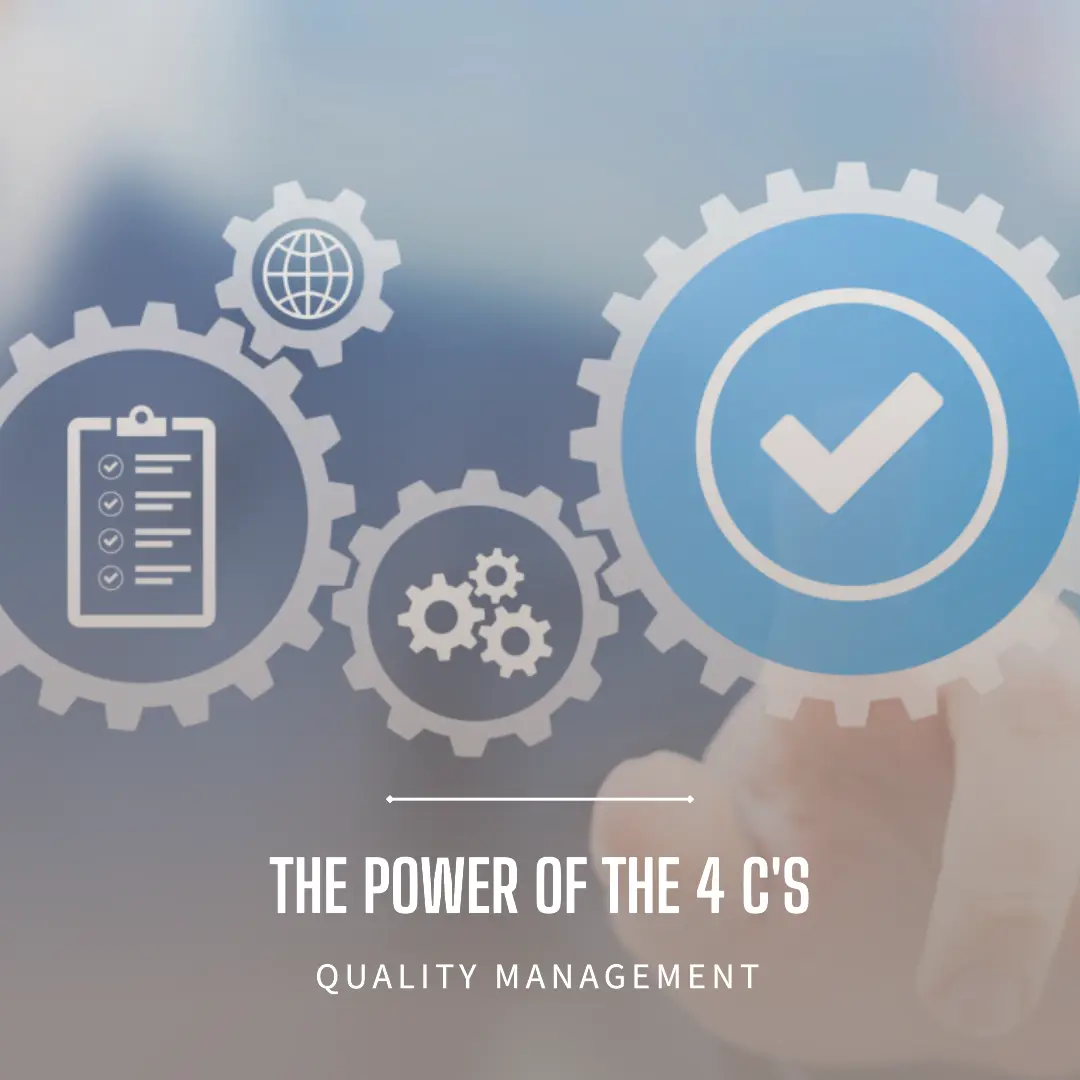I. Introduction
Have you ever wondered why some projects seem to run seamlessly while others struggle to stay on track? The answer often lies in the foundation on which they are built. In the world of project management, that foundation is quality management. Today, we’re going to explore the power of the 4 C’s: Communication, Collaboration, Commitment, and Continuous Improvement. These are the cornerstones of a robust project quality management system, and when implemented effectively, they can lead to higher project success rates and increased stakeholder satisfaction. So, buckle up and let’s dive into the fascinating world of the 4 C’s!
A. Briefly introduce the concept of quality management in projects
Imagine you’re building a house. You wouldn’t start without a solid foundation, right? The same applies to projects. Quality management is that essential foundation that supports every aspect of a project from start to finish. It involves planning, executing, and monitoring the activities necessary to achieve the desired results while meeting stakeholder expectations. In other words, it’s all about ensuring that your project delivers the best possible value.
B. Importance of project success rates and stakeholder satisfaction
Now, you may be wondering why project success rates and stakeholder satisfaction matter so much. Well, think about it: the ultimate goal of any project is to deliver a valuable outcome that satisfies everyone involved. Achieving this goal not only enhances your organization’s reputation but also leads to more opportunities for future projects and growth. Stakeholder satisfaction is the key to unlocking a world of possibilities for your organization.
C. Introduce the 4 C’s as key elements to build a strong project quality management foundation
This brings us to the 4 C’s – the secret ingredients that can help you create a strong project quality management foundation. These four elements work together to create a harmonious environment where your project can thrive. The 4 C’s are:
- Communication: Ensuring that everyone is on the same page and working towards the same goals.
- Collaboration: Encouraging team members to share ideas and work together to solve problems.
- Commitment: Motivating your team to stay focused on their goals and persevere through challenges.
- Continuous Improvement: Striving for excellence by constantly evaluating and refining your processes.
Ready to unlock the power of the 4 C’s? Stay tuned as we delve deeper into each of these essential elements and learn how they can transform your project quality management approach!
II. Communication
A. Define communication in the context of project management
Let’s start with the first of the 4 C’s: Communication. In the context of project management, communication is the lifeblood that keeps the entire team in sync. It’s the process of sharing information, ideas, and feedback among team members, stakeholders, and anyone else involved in the project. It’s not just about talking, though. It’s about listening, understanding, and actively engaging with one another to ensure that everyone’s on the same page.
B. Discuss the importance of effective communication for project success
Think about your favorite sports team. What sets them apart from the competition? More often than not, it’s their ability to communicate effectively with one another, both on and off the field. The same is true for project teams. A project can only succeed if everyone involved understands their roles, responsibilities, and how their work contributes to the overall goal. In fact, studies have shown that effective communication is one of the top predictors of project success. So, never underestimate the power of a well-timed conversation or a carefully crafted email.
C. Describe communication channels and tools
In our fast-paced, digital world, we have more communication channels and tools at our disposal than ever before. But, with great power comes great responsibility. It’s essential to choose the right channels and tools to suit your team’s needs and preferences. Some popular options include:
- Email: The tried-and-true method for sharing updates and important information.
- Instant Messaging: Perfect for quick questions and real-time collaboration.
- Video Conferencing: Ideal for face-to-face meetings, even when you’re miles apart.
- Project Management Tools: Platforms that combine communication and task management, keeping everything in one place.
Don’t be afraid to experiment and find the mix that works best for your team.
D. Share best practices for effective communication within project teams
So, how can you make sure your team’s communication game is strong? Here are a few best practices to get you started:
- Set clear expectations: Establish communication guidelines, such as response times and preferred channels, at the beginning of the project.
- Be concise and clear: Keep your messages focused, and avoid using jargon or overly technical language that could create confusion.
- Listen actively: Show your team that their input is valued by actively listening to their ideas and concerns, and addressing them accordingly.
- Encourage open dialogue: Create an environment where team members feel comfortable sharing their thoughts and opinions without fear of retribution.
By mastering the art of communication, you’re already well on your way to building a solid project quality management foundation. Stay tuned as we explore the next critical component: Collaboration!
III. Collaboration
A. Define collaboration in the context of project management
As we move on to the second of the 4 C’s, let’s talk about Collaboration. In the realm of project management, collaboration is all about working together as a team to achieve a common goal. It involves sharing ideas, resources, and expertise to develop creative solutions, solve problems, and ultimately, deliver a successful project. When a team collaborates effectively, they can overcome even the most daunting challenges.
B. Explain the relationship between collaboration and project success
Imagine trying to solve a complex puzzle with your eyes closed. Sounds pretty difficult, right? That’s what it’s like working on a project without effective collaboration. When team members don’t work together, important pieces of the puzzle can be overlooked, leading to delays, errors, and even project failure. On the other hand, when a team is united and collaborates seamlessly, they can pool their knowledge, skills, and talents to achieve amazing results. It’s no wonder that strong collaboration is closely linked to project success.
C. Discuss strategies for fostering a collaborative environment
Creating a collaborative environment doesn’t happen by accident. It takes intention, effort, and a little bit of strategic planning. Here are some strategies to help you foster collaboration within your team:
- Set clear goals and expectations: Make sure every team member understands the project objectives and their role in achieving them.
- Encourage open communication: Create a safe space for team members to express their thoughts, ask questions, and offer feedback without judgment.
- Provide the right tools and resources: Equip your team with collaboration tools, such as shared documents, whiteboards, and video conferencing platforms, to streamline their collaborative efforts.
- Celebrate teamwork: Recognize and reward instances of exceptional collaboration, both individually and as a team.
D. Share tools and techniques to enhance collaboration
When it comes to collaboration, having the right tools and techniques can make all the difference. Here are a few popular options to consider:
- Cloud-based file sharing: Platforms like Google Drive and Dropbox allow team members to access and edit documents in real-time, ensuring everyone is working from the most up-to-date information.
- Collaborative workspaces: Tools like Trello, Asana, and Monday.com help teams organize tasks, track progress, and collaborate on project-related work.
- Video conferencing and screen sharing: Platforms like Zoom and Microsoft Teams enable face-to-face meetings and real-time collaboration, regardless of physical location.
- Brainstorming sessions: Schedule regular brainstorming sessions where team members can share ideas, discuss challenges, and work together to develop innovative solutions.
As you can see, collaboration is a vital ingredient in the recipe for project success. Stay tuned as we delve into the next essential element of the 4 C’s: Commitment!
IV. Commitment
A. Define commitment in the context of project management
Now that we’ve covered Communication and Collaboration, it’s time to tackle the third of the 4 C’s: Commitment. In project management, commitment refers to the dedication and determination of the team members to achieve the project’s goals. It’s about staying focused on the task at hand, persevering through challenges, and going the extra mile to ensure the project’s success. A committed team is a powerful force to be reckoned with, capable of overcoming even the toughest obstacles.
B. Explain why commitment is crucial for project success
Have you ever watched a marathon? The runners who cross the finish line aren’t always the fastest or the strongest. Often, they’re the ones with the most commitment – the ones who refuse to give up, no matter how difficult the race becomes. The same principle applies to project management. Commitment is the fuel that drives a team to push through setbacks, stay focused on the end goal, and ultimately, deliver a successful project. Without commitment, even the most skilled and experienced team may struggle to reach the finish line.
C. Discuss strategies for fostering commitment within project teams
So, how can you inspire commitment within your project team? Here are a few strategies to consider:
- Lead by example: As the project manager, demonstrate your own commitment to the project by working diligently, staying engaged, and maintaining a positive attitude.
- Set clear, achievable goals: Break the project down into smaller, manageable tasks, and ensure each team member understands their role in accomplishing these tasks.
- Provide regular feedback and recognition: Praise team members for their hard work, dedication, and accomplishments, and offer constructive feedback to help them grow and improve.
- Foster a sense of ownership: Encourage team members to take responsibility for their work and to feel personally invested in the project’s success.
D. Share tips for maintaining commitment throughout the project lifecycle
Keeping the flame of commitment burning throughout the entire project lifecycle can be challenging. Here are some tips to help you maintain momentum and keep your team motivated:
- Communicate progress: Regularly update your team on the project’s progress, celebrating milestones and addressing any challenges that arise.
- Offer support and resources: Ensure your team has access to the tools, training, and support they need to perform at their best.
- Encourage work-life balance: Promote a healthy balance between work and personal life to prevent burnout and keep team members energized.
- Stay adaptable: Be prepared to adjust your plans and strategies as needed, demonstrating flexibility and resilience in the face of change.
With a committed team by your side, your project is well on its way to success. But don’t stop there – stay tuned as we explore the final component of the 4 C’s: Continuous Improvement!
V. Continuous Improvement
A. Define continuous improvement in the context of project management
We’ve finally arrived at the last of the 4 C’s: Continuous Improvement. In project management, continuous improvement is the ongoing effort to evaluate, refine, and enhance processes, systems, and performance throughout the project lifecycle. It’s about fostering a mindset of growth and innovation, where the pursuit of excellence never ends. By embracing continuous improvement, your team can unlock new levels of efficiency, effectiveness, and overall project success.
B. Discuss the importance of continuous improvement for project success
Think about your favorite smartphone brand. What sets it apart from the competition? Chances are, it’s their commitment to continuous improvement – constantly seeking ways to make their products faster, more powerful, and more user-friendly. In project management, the same principle applies. By actively seeking and implementing improvements, your team can stay ahead of the curve, adapt to changing conditions, and deliver exceptional results. It’s a game-changer that can propel your projects to new heights.
C. Explain how to establish a culture of continuous improvement within project teams
Creating a culture of continuous improvement doesn’t happen overnight. It requires a shift in mindset, as well as the right strategies and support. Here’s how you can get started:
- Lead by example: As the project manager, demonstrate your commitment to continuous improvement by actively seeking feedback, learning from mistakes, and implementing positive changes.
- Encourage open communication: Foster an environment where team members feel comfortable sharing their ideas, suggestions, and concerns without fear of judgment or reprisal.
- Implement regular reviews and assessments: Schedule periodic reviews of project processes, performance, and outcomes to identify areas for improvement and track progress.
- Provide training and development opportunities: Equip your team with the skills and knowledge they need to identify and implement improvements, and encourage ongoing learning and growth.
D. Share methods and tools for tracking and measuring improvements
Measuring and tracking improvements is crucial for ensuring that your continuous improvement efforts are making a meaningful impact. Here are some methods and tools to help you stay on track:
- Key Performance Indicators (KPIs): Establish measurable indicators of success that align with your project’s goals and objectives, and monitor them regularly to assess progress.
- Benchmarking: Compare your project’s performance against industry standards, best practices, or past projects to identify areas for improvement and set targets.
- Feedback surveys: Gather input from team members, stakeholders, and other relevant parties to gauge satisfaction levels and identify potential areas for improvement.
- Process mapping and analysis: Visualize and analyze your project’s processes to identify inefficiencies, bottlenecks, and opportunities for optimization.
By mastering the art of continuous improvement, you’ll be well-equipped to tackle any project with confidence and finesse. Now that you’ve discovered the power of the 4 C’s, it’s time to put your newfound knowledge to work and start building your project quality management foundation! Good luck, and remember: Communication, Collaboration, Commitment, and Continuous Improvement are the keys to success.
VI. Conclusion
A. Recap the importance of the 4 C’s in project quality management
As we wrap up our journey through the 4 C’s, it’s important to remember just how crucial these elements are in building a solid project quality management foundation. Communication, Collaboration, Commitment, and Continuous Improvement work together in harmony, helping your team stay focused, united, and driven to achieve their goals. By mastering these four elements, you can significantly improve project success rates and stakeholder satisfaction, propelling your organization to new heights.
B. Encourage readers to apply the 4 C’s in their projects
Now that you have a deeper understanding of the 4 C’s, it’s time to put them into practice in your own projects. Start by assessing your current approach to project management and identifying areas where you can strengthen your focus on Communication, Collaboration, Commitment, and Continuous Improvement. Remember, Rome wasn’t built in a day, and neither will your project quality management foundation. Be patient, persistent, and open to learning from your experiences along the way.
C. Offer resources and additional information
To help you on your journey, consider exploring additional resources, such as books, online courses, and industry blogs, to expand your knowledge of project quality management and the 4 C’s. You can also reach out to industry peers, mentors, or project management professionals to gain valuable insights and advice. Remember, knowledge is power, and the more you learn, the better equipped you’ll be to tackle any project that comes your way.
D. Invite feedback and questions from readers
Lastly, we’d love to hear from you! Share your thoughts, experiences, and questions in the comments section below, and let’s continue the conversation on the power of the 4 C’s. Together, we can support each other in our quest for project management excellence and help build a brighter, more successful future for our organizations.
Thank you for joining us on this exciting exploration of the 4 C’s. We wish you the best of luck in your project management endeavors and can’t wait to see the incredible results you’ll achieve by harnessing the power of Communication, Collaboration, Commitment, and Continuous Improvement. Happy project managing!
To find out how Artificial Intelligence is changing the Project Management landscape, you have enjoy reading this article https://www.shaunstoltz.com/did-artificial-intelligence-just-change-everything-about-project-management/
Find out more about Shaun Stoltz https://www.shaunstoltz.com/about/
This post was written by an AI and reviewed/edited by a human.



